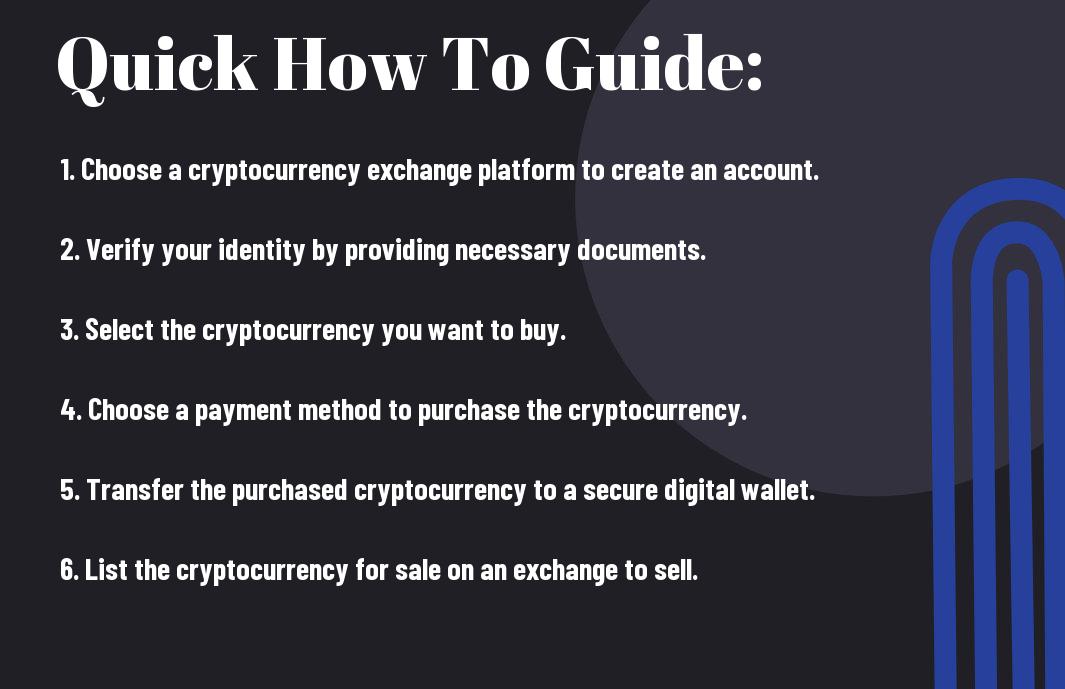Ready to explore cryptocurrency trading? Digital currencies are on the rise, making trading them a popular investment. New to this space? It can feel overwhelming. Where do you begin? This post covers the basics of buying and selling cryptocurrency. You’ll learn how to set up an exchange account and make your first trade. By the end, you’ll have the knowledge and confidence to trade cryptocurrency like a pro!
Key Takeaways:
- Choose a reputable exchange: When buying and selling cryptocurrency, it’s important to select a trustworthy and secure exchange. Look for exchanges that have a strong reputation, robust security measures, and are regulated by relevant authorities. This will help protect your assets and personal information.
- Understand the different types of orders: There are various types of orders you can place when buying and selling cryptocurrency, including market orders, limit orders, and stop-loss orders. Understanding the differences between these orders can help you make informed trading decisions and minimize potential losses.
- Store your assets securely: Once you’ve purchased cryptocurrency, it’s crucial to store it in a secure wallet. You can choose from hot wallets (connected to the internet) or cold wallets (offline storage). Consider using a hardware wallet or a paper wallet for added security, and always keep your private keys safe and confidential.

Understanding Cryptocurrency Markets
Before venturing into the world of cryptocurrency trading, it’s necessary to understand the markets and what drives them. This knowledge will help you make informed decisions when buying and selling cryptocurrencies.
Factors to Consider Before Buying Cryptocurrency
With the vast number of cryptocurrencies available, it’s crucial to consider several factors before making a purchase. You should evaluate the market capitalization, liquidity, and volatility of the cryptocurrency. Additionally, research the development team, community support, and security features of the cryptocurrency. Assume that thorough research will help you avoid potential pitfalls and make a more informed investment decision.
- Market capitalization: The total value of the cryptocurrency’s outstanding coins or tokens.
- Liquidity: The ease with which you can buy or sell the cryptocurrency without significantly affecting its price.
- Volatility: The fluctuation in the cryptocurrency’s price over time.
- Development team: The team behind the cryptocurrency, responsible for its development and maintenance.
- Community support: The level of enthusiasm and involvement from the community surrounding the cryptocurrency.
- Security features: The measures in place to protect the cryptocurrency from hacking and other security threats.
Tips for Choosing the Right Cryptocurrency to Invest In
Right from the start, it’s necessary to choose a cryptocurrency that aligns with your investment goals and risk tolerance. You should look for cryptocurrencies with a strong use case, active development, and a growing user base. Recognizing these factors will help you identify cryptocurrencies with potential for long-term growth.
- Strong use case: A clear and practical application of the cryptocurrency.
- Active development: Regular updates and improvements to the cryptocurrency’s underlying technology.
- Growing user base: An increasing number of users adopting and utilizing the cryptocurrency.
Another crucial aspect to consider when choosing a cryptocurrency is its scalability and adoption rate. You should also evaluate the competition in the cryptocurrency’s specific market niche. By considering these factors, you can increase your chances of investing in a cryptocurrency that will appreciate in value over time. Recognizing the importance of thorough research will help you avoid costly mistakes and achieve your investment goals.
- Scalability: The cryptocurrency’s ability to handle a large number of transactions per second.
- Adoption rate: The rate at which the cryptocurrency is being adopted by new users and businesses.
- Competition: The number of other cryptocurrencies competing in the same market niche.

How to Buy Cryptocurrency
Some people may think that buying cryptocurrency is a complex process, but it’s actually quite straightforward. Here’s a step-by-step guide to help you get started.
Setting Up a Cryptocurrency Wallet
A little preparation is necessary before you start buying cryptocurrency. You’ll need a digital wallet to store your coins. There are many types of wallets available, including software wallets, hardware wallets, and paper wallets. Choose a reputable provider and follow their instructions to set up your wallet.
Finding a Reputable Cryptocurrency Exchange
With so many exchanges available, it’s imperative to find a reputable one. Look for exchanges that are well-established, have a strong reputation, and offer good customer support. Check online reviews and ratings to help you make an informed decision.
Cryptocurrency exchanges are vulnerable to hacking, so it’s crucial to choose an exchange that has a strong track record of security. Make sure the exchange you choose has robust security measures in place, such as two-factor authentication and cold storage.
Funding Your Account and Making a Purchase
Purchase the cryptocurrency of your choice by funding your exchange account with fiat currency or another cryptocurrency. The process is similar to buying stocks or forex. Simply select the cryptocurrency you want to buy, enter the amount, and confirm the transaction.
It’s imperative to understand the fees associated with buying cryptocurrency. Be aware that exchanges charge fees for transactions, and these fees can eat into your profits. Additionally, make sure you understand the exchange’s withdrawal policies and any potential restrictions.
How to Sell Cryptocurrency
Unlike buying cryptocurrency, selling it requires a more strategic approach to maximize your profits. Here’s a step-by-step guide to help you navigate the process.
Understanding Market Trends and Timing Your Sale
To ensure a profitable sale, you need to stay up-to-date with market trends and analyze them to determine the best time to sell. Keep an eye on market fluctuations, news, and events that may impact the value of your cryptocurrency. Timing is crucial, as selling too early or too late can result in significant losses.
Using Stop-Loss Orders to Minimize Losses
Even if you’re not actively monitoring the market, you can set a stop-loss order to automatically sell your cryptocurrency when it reaches a certain price. This helps limit your potential losses if the market suddenly drops.
Trends can be unpredictable, and prices can fluctuate rapidly. A stop-loss order acts as a safety net, ensuring that you don’t hold onto a cryptocurrency that’s rapidly losing value. Set a realistic stop-loss price based on your risk tolerance and market analysis to minimize potential losses.
Withdrawing Your Funds and Managing Taxes
Sale proceeds can be withdrawn to your bank account or used to purchase other cryptocurrencies. However, don’t forget to consider the tax implications of your sale. Keep accurate records of your transactions, as you may need to report capital gains or losses on your tax return.
It’s imperative to understand the tax laws in your country and how they apply to cryptocurrency transactions. Consult with a tax professional or financial advisor to ensure you’re meeting your tax obligations. Failing to report cryptocurrency income can result in penalties and fines, so it’s crucial to stay compliant.
Advanced Tips for Buying and Selling Cryptocurrency
Your cryptocurrency trading journey doesn’t stop at the basics. To take your skills to the next level, consider the following advanced tips:
- Table of Advanced Tips
Tips Description Diversifying Your Portfolio Spread your investments across different cryptocurrencies to minimize risk. Using Technical Analysis Analyze market trends and patterns to make informed investment decisions. Staying Up-to-Date with Market News and Regulations Stay informed about market fluctuations and regulatory changes to stay ahead.
Diversifying Your Portfolio to Manage Risk
An important strategy for minimizing risk is to diversify your portfolio by investing in a mix of different cryptocurrencies. This way, if one cryptocurrency takes a hit, the others can help balance out your losses.
Using Technical Analysis to Make Informed Decisions
Using technical analysis, you can identify patterns and trends in the market to make informed investment decisions. By studying charts and graphs, you can predict price movements and adjust your strategy accordingly.
To take your technical analysis to the next level, consider using indicators such as moving averages, relative strength index (RSI), and Bollinger Bands. These tools can help you identify trends and make more accurate predictions.
Staying Up-to-Date with Market News and Regulations
Diversifying your sources of information is crucial in staying up-to-date with market news and regulations. Follow reputable sources, such as CoinDesk and CoindTelegraph, to stay informed about market fluctuations and regulatory changes.
For instance, if a country announces new regulations on cryptocurrency trading, you’ll want to be aware of how it may affect your investments. Staying informed can help you make informed decisions and avoid potential pitfalls.
Summing up
From above, you now know the basics of buying and selling cryptocurrency. You’ve learned how to set up a digital wallet, choose a reputable exchange, and navigate the process of buying and selling crypto assets. Remember to always do your research, stay informed, and prioritize security when managing your cryptocurrency transactions. If you’re ready to get started, consider checking out Crypto.com | Securely Buy, Sell & Trade Bitcoin, Ethereum…, a popular platform for buying, selling, and trading cryptocurrency. Happy trading!
FAQ
Q: What is the first step to buying cryptocurrency?
A: The first step to buying cryptocurrency is to create an account on a reputable cryptocurrency exchange. There are many exchanges to choose from, such as Coinbase, Binance, and Kraken, among others. Once you’ve selected an exchange, you’ll need to provide some personal information, such as your name, email address, and password, to create an account. You may also need to verify your identity by uploading a government-issued ID and proof of address. This is a standard security measure to prevent fraud and ensure compliance with anti-money laundering regulations.
Q: How do I fund my cryptocurrency exchange account and purchase cryptocurrency?
A: Once your account is created and verified, you’ll need to fund it with fiat currency (such as USD, EUR, or JPY) to buy cryptocurrency. You can do this using a variety of payment methods, including bank transfers, credit/debit cards, and online payment services like PayPal. The specific payment options available will depend on the exchange you’re using. After funding your account, you can browse the exchange’s marketplace and select the cryptocurrency you want to buy. Enter the amount you want to purchase, and the exchange will execute the trade at the current market price. The cryptocurrency will then be deposited into your exchange wallet.
Q: How do I sell my cryptocurrency and withdraw the funds?
A: To sell your cryptocurrency, follow the same steps as when you bought it, but in reverse. Go to the exchange’s marketplace and select the cryptocurrency you want to sell. Enter the amount you want to sell, and the exchange will execute the trade at the current market price. The proceeds from the sale will be deposited into your exchange wallet in fiat currency. From there, you can withdraw the funds to your bank account or other external wallet using the exchange’s withdrawal options. Be aware that some exchanges may have minimum withdrawal amounts or fees for certain withdrawal methods, so be sure to review the exchange’s terms and conditions before making a withdrawal.

